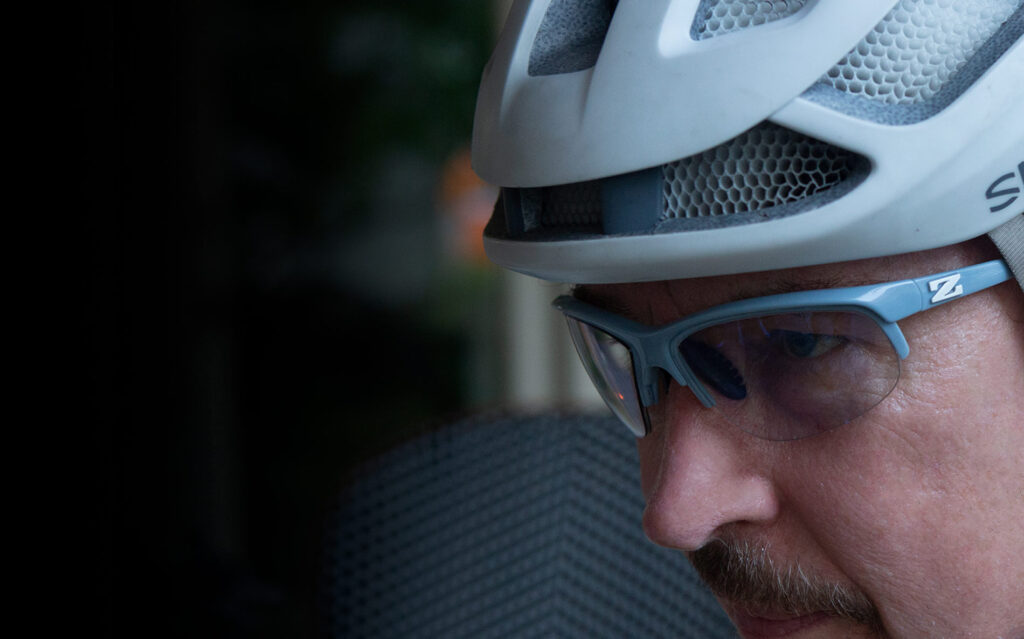“If you want something new, you have to stop doing something old”
― Peter Drucker
Have you ever noticed the frequency with which cyclists stick their sunglasses into their helmets? You see it all the time, on your group ride or in a pro peloton. In bright sunny weather or on cloudy, blustery and rainy days there they are, upside down hanging just above where they really need to be. Today’s sport sunglasses seem to have taken their rightful place, stuck in a rider’s helmets.
Have you noticed this phenomenon occurs exactly when physical exertions and weather are at their most difficult and hazardous?
In fact the occurrence sunglasses sticking out of a helmet is so common in cycling no one gives it a second thought.
Have you ever wondered why?
A short look back in time may provide the answer.
Originally eyewear showed up in the peloton, not for protection from the sun but protection from the dirt, grit and bugs that resulted from riding on unpaved roads. In the early twentieth century, post-World War I military surplus flying goggles made from glass and leather seemed to provide the necessary protection.
Believe it or not the use of goggles remained the go-to eyewear in cycling until the 1950’s! That’s right the 1950’s and beyond! Some modifications had been made to materials of course. They were using rubber instead of leather, but for a very long time goggles were the eyewear preferred by the peloton if they wore any eye protection at all!
Now, here is where it gets interesting. Apparently, there were some fairly significant technological advancements in sunglasses during this period, but the European cycling peloton did not adapt this new technology.
Admittedly, the world was a different place back then. Communications and travel were not what they are today, but these sunglasses were immensely popular, particularly with the Hollywood set.
So why didn’t the peloton jump on the new technology given the sport of cycling demands more from sunglasses than any other sport?
Good question.
It was a product that was developed as a result of advancing aviation technology and another world war (World War II) that offered a vision protection alternative that some in the peloton began to wear.
Finally, a few in the professional peloton began to wear a product that offered new technology! One might think that you would have seen these sunglasses on every face in the peloton, but that was not the case. Fausto Coppi and few others, but the rest were still wearing goggles or nothing at all.
All through the 60’s and 70’s most of the riders seen wearing glasses in the peloton were the guys needing vision correction. The French Tour de France winner Laurent Fignon is a good example.
It would be another 30 years before a guy by the name of Jim Jannard and his dog Oakley came upon the scene.
In the 1980’s while most professional riders were either wearing aviator style sunglasses or no sunglasses at all (which was still the preference),
a guy by the name of Greg LeMond debuted a pair of ski goggles he had purchased, called Oakley Eyeshades and won the 1986 Tour De France.
The idea of sports sunglasses was born.
Which brings us to today, 30 years later. There has been a lot of minor adjustments and modifications in materials and tints to those sunglasses worn by Greg LeMond, but today’s sports sunglasses remain essentially unchanged from those days.
Interestingly, none of the sunglasses used by the professional peloton or cycling enthusiasts today were designed specifically for cycling. Rather they are adaptations of eye protection designed for another purpose. Whether it was aviation or skiing none of the cycling sunglasses worn today have been designed specifically for cycling. The sunglasses worn today are all classified under the “sports” category for a reason. It is generic to all sports and outdoor activities and it is old technology.
We at Zoran find this “sports category” interesting as none of the other sports we can think of put the demands on sunglasses that cycling does.
Think about it. We ride up mountains, scream down mountains in all weather conditions. We ride in hot windy conditions and cold raining miserable weather. We ride in the light and in the dark, through tunnels and in the woods over trails. We ride everywhere all year long! What other sport does that? Running? Maybe, but not at the speeds we ride which puts even more demands on our ability to see!
Another interesting consideration is that every other product in the sport of cycling has adapted their products to ride in all of these conditions, from tires to shoes and clothing. All products, that is, except sunglasses. So the next time go for a ride think about this. Those sunglasses you’re riding are very old technology, they weren’t designed for cycling and they don’t work all that great. That’s why they are stuck in your helmet!
The first sunglasses ever designed specifically for cycling. Zoran has taken advantage of all of the technological advancements in materials and coatings that have occurred in the optical eyewear industry and adapted them to cycling eyewear including prescriptions!
